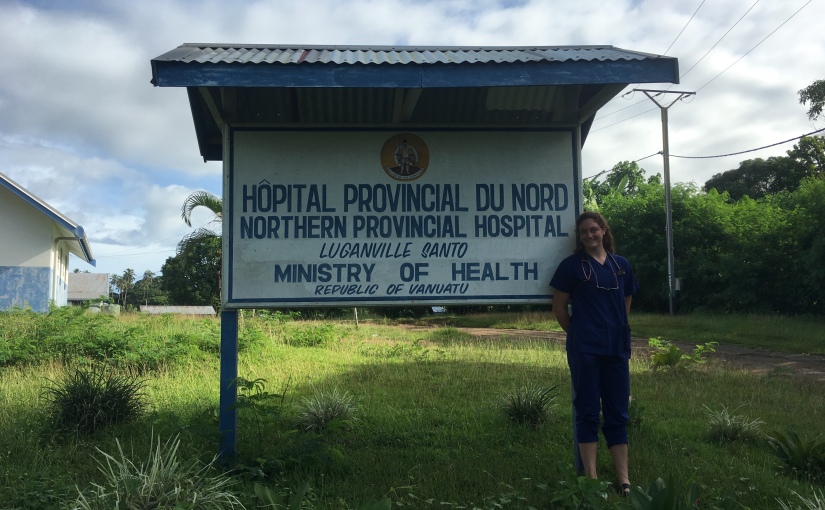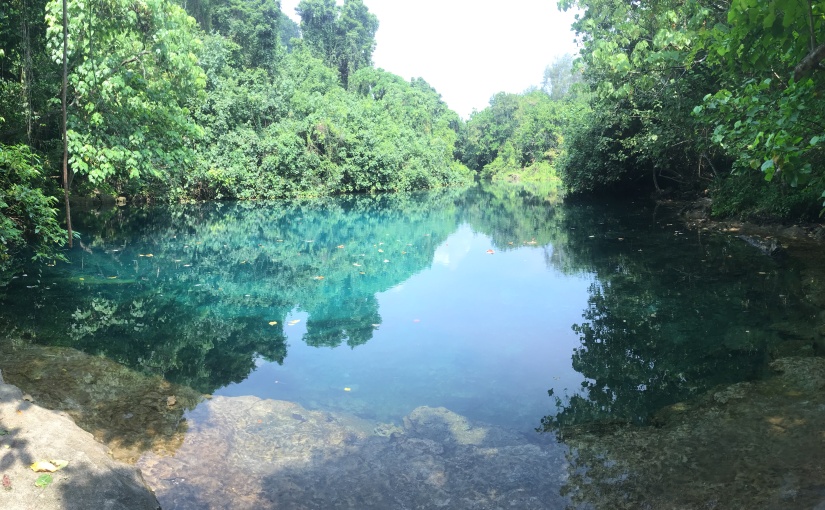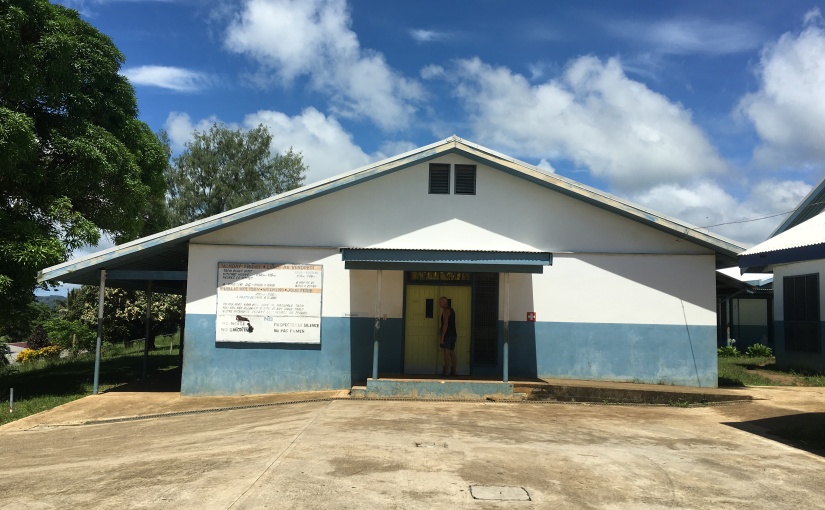Every day at the hospital starts with a 15 minute walk up a reasonably steep hill. By the time you arrive at the hospital you’re soaked with sweat and your glasses are foggy, no matter what the weather is like! The local Ni-Van people are notoriously friendly, so you can expect to say hello or wave to every single person you walk past, as well as receive friendly beeps and waves from cars passing by. Often there are utes with their trays stacked with people, all smiling and waving! The hospital has a few different areas; ED, medical ward, surgical ward, maternity ward, paediatrics ward, TB ward, outpatients area, theatre, radiology and pathology.
I began my elective in ED on my own, welcomed by the lovely head nurse Claudine. The nurses there wear white dress uniforms, and the head nurse is recognised by red patches on their shoulders. Claudine taught me some basic Bislama, the local pidgin language, so that I could communicate with patients and get a basic history. The ED there has three beds plus one resus bay, with curtains dividing the adjoining bays. The room has louvres for windows, which are pretty much always open no matter what is happening inside the bays. This didn’t seem to bother the Ni-Vans who came in for treatment, as modesty wasn’t a big concern in general. This in itself was strange for me, coming from Australian hospitals where there is a painstaking effort to maintain modesty for all patients.
As far as I could tell, there wasn’t a triage system in place. Patients who would be Cat 4 or 5 in Australia went to the Outpatient area, which among specialist clinics seemed to operate as a GP service. It was a bit confusing for me being in ED, as I wasn’t sure which patients were supposed to be getting seen and which were to be sent away. Quite a few patients came through for salbutamol nebulisers (an alarming amount, given it’s not something done particularly often at home), and some for IM penicillin jabs. The IM penicillin was something I was used to seeing being administered in Broome for skin sores, and it seemed to serve the same purpose here as rheumatic heart disease is prevalent here, too. Only certain medications are in stock, so sometimes things need to be crushed and mixed with some fluid to be given as a syrup rather than a tablet for someone who can’t swallow well. Luckily, they have a rock for crushing medicines on hand.
The big difference I noticed between procedures – besides using salbutamol nebs for a variety of patients, including a kid who probably had bronchiolitis – is that everything is reused. The masks are reused for the nebs, and a syringe sits on the bench for drawing up saline and salbutamol – both of which remain on the bench to be used up over the course of the day/week. The vials of penicillin for IM injection were also used for as many patients as they could, to save equipment. When cannulas were put in, blood was dripped into tubes instead of using a syringe to draw blood out. ECG dots were reused, even when they were covered in someone else’s chest hair. This made me realise how lucky we are in Australia to have so many disposable items at our fingertips, and that we have plentiful resources so that hardly anything is reused. Where I used to be shocked at the amount of wastage in hospitals in Australia, I was now shocked at how little was wasted here.
Other things I had taken for granted in Australia; alcohol wipes, paper towels, alcohol hand rub, liquid soap, lancets for BSLs, computers, lab reagents, vomit bags, blueys, IVC dressings, bleach… things are quite basic here. When something runs out, everyone has to wait. For example, the lab has run out of reagents for UEC and LFT tests – so only pregnant women with possible pre-eclampsia get UECs. Sometimes they don’t have the right equipment for Hep B serology, so routine screening for pregnant women is disrupted. Currently the only tests you can order routinely are; FBC, ESR and malarial parasites (plus the standard microbiology tests). If you do someone’s BSL, you find a small needle and quickly stab them in the manner of a lancet. Luckily there are glucometers and test strips, as diabetes is a big problem here. If someone is getting cannulated, you need to find a cotton ball and squirt some alcohol onto it to serve as a wipe. To wash your hands, there is running water and a bar of soap, and if you’re lucky there might be a towel hanging there to dry your hands with, although often not. And if someone vomits on the floor, currently there’s a bleach shortage so it just gets mopped up with some water.
As for imaging, X-Ray is available, and there are lightboxes for you to be able to see the plain film. There isn’t a radiologist to report on them though, so you just have to find the best person to double check it for you. Ultrasound is available, however the reports are usually a few sentences at best, recorded on the small piece of paper that serves as the request, and you hardly ever get any images. The shortest report I saw was ‘RPOC’ – retained products of conception. Much snappier than the reports we get in Australia – they really do get straight to the point here.
So seeing patients in ED, with very limited investigations at my fingertips, it really is about a good history and clinical examination. Unfortunately, the people of Vanuatu are among the most stoic I have ever come across, and those coming to ED who are sick are usually incredibly sick. All records are handwritten, and not many have files as thick as our Australian patients. It amazes me how the medical records team find anyone’s file – it’s all hand-written, most people I’ve come across don’t know their date of birth (and their age they admit to seems to change their birth year every time they attend the hospital), so the additional information they ask for are parents’ names and island of origin. If they do find the folder, you are left with a stack of pages which are not necessarily dated, in time order, signed or legible. Often there are no record of medications on discharge or regular meds. It’s a challenge, and all you can do is your best!
Some of the interesting cases we had included;
- A young girl of 11 who came in with sudden onset paralysis of both legs and one arm. She’d had a couple of weeks of pain in her legs, then the day prior had collapsed in the kitchen. She had been otherwise well. On examination, she had decreased tone, power 1/5 both legs and left arm, power 3/5 in right arm, absent deep tendon reflexes, and grossly normal sensation. Cranial nerves were normal. It was later found she had dislocated her femoral head when she fell down, although she didn’t admit to any pain. One day later, the paralysis had started to encroach on her respiratory muscles, and she was in distress. As NPH only has a ventilator in theatre, she was sent to Vila. Her doctors were thinking maybe Guilliame-Barre Syndrome or spinal TB. I later found out that she died from respiratory failure before she made it onto a ventilator, and the working diagnosis was still GBS despite the rapid onset.
- A woman with incomplete miscarriage who arrived to ED on a blood-soaked tarp on the back of a ute, moaning and shocked. It had been a long and bumpy journey. She ended up going for a D&C in theatre, which was performed under ketamine and propofol, with just an oxygen mask to manage her airway. She was discharged a day later.
In terms of out-of-hospital activities, we went to Nanda Blue Hole for a traditional lunch and to see how kava is made, as well as doing Millenium Cave and going to the private island Ratua for a day of swimming, snorkelling, SUPing and eating. Nanda is absolutely amazing, the bluest of the holes and wonderful to swim in. Millenium Cave was a huge day – it involves 1.5 hours of hiking, 45 minutes of caving, 45 minutes of canyoning and 45 minutes floating down a gorge river past waterfalls and hanging vines. The canyoning was the highlight – climbing over rocks, upright wooden ladders, crossing fast flowing streams holding on a rope all while it steadily rained. Ratua was worth doing, especially for the Sunday buffet and the snorkelling!

ED bays

medicine-crushing rock

standard hospital attire












